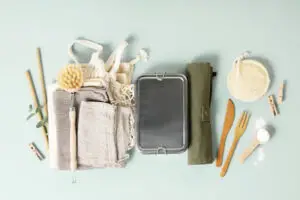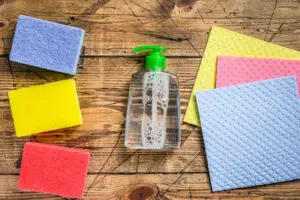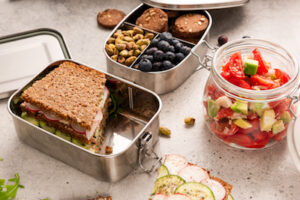How to Clean a Vintage Lunch Box Tips
Vintage lunch boxes are a popular collector’s item, especially among those who enjoy nostalgic items from the past. Whether you’re a collector or just looking to restore an old lunch box, it’s important to know how to clean and maintain it properly. For most vintage lunch boxes, it is not recommended to put them in the dishwasher, as the heat and harsh soaps can damage them. So how do you clean a vintage lunch box?
There are 4 main steps for how to clean a vintage lunch box:
- Gather Supplies- this includes a soft brush, gloves, and mild soap.
- Clean The Exterior- do a dry clean and then a deeper “wet” clean.
- Clean The Interior- make sure to use non-toxic, food-safe cleaning products.
- Dry and Polish- this step could be optional depending on what your plans for the lunch box are.
In this blog article, we’ll go over these steps in more detail and cover some of the best ways to preserve a vintage lunch box and keep it looking great for years to come.

Step 1: Gather Your Supplies
Before you begin cleaning your vintage lunch box, you’ll need to gather a few supplies. Here’s what you’ll need:
- Soft-bristled brush
- Mild dish soap
- Warm water
- Soft Cloths or sponges
- Baking soda
- Vinegar
- Q-tips
- Rubbing alcohol (isopropyl alcohol)
- Paper towels
- Gloves (optional)
When it comes to choosing a soft-bristled brush, look for one that’s specifically designed for cleaning delicate surfaces. You’ll also want to make sure to use a cleaning product that is meant for the material of the lunch box, whether it’s made of tin or plastic.

Step 2: Clean the Exterior
The first step in cleaning a vintage lunch box is to clean the exterior. Do a “dry-cleaning” first to remove dust and dirt and food particles. Use a soft-bristled brush to remove any loose dirt or debris from the surface of the lunch box. Then, mix a small amount of mild dish soap with warm water and use a soft cloth or sponge to gently clean the surface of the lunch box. Be sure to rinse the cloth or sponge frequently to avoid spreading dirt around.
If the lunch box has stubborn stains or grime on the exterior, mix a paste of baking soda and water and apply it to the affected areas. Use a soft-bristled brush to gently scrub the paste into the surface of the lunch box, then rinse thoroughly with warm water.
For metal lunch boxes, you can also use a mixture of equal parts vinegar and water to remove any rust or discoloration. Apply the mixture to the affected areas with a soft cloth or sponge and allow it to sit for a few minutes before wiping it away with a clean, damp cloth.
Step 3: Clean the Interior
Next, it’s time to clean the interior of the lunch box. If the lunch box has a removable tray or compartment, remove it and wash it separately in warm, soapy water. Use a soft-bristled brush or Q-tips to clean any hard-to-reach areas. If you plan to use the vintage lunch box, you’ll want to make sure to use non-toxic, food-safe cleaning products.
For the main interior of the lunch box, mix a small amount of mild dish soap with warm water and use a soft cloth or sponge to clean the surface. Be sure to rinse the cloth or sponge frequently to avoid spreading dirt around.
If the interior of the lunch box has strong odors, you can use a mixture of equal parts vinegar and water to neutralize them. Apply the mixture to the interior of the lunch box with a soft cloth or sponge and allow it to sit for a few minutes before wiping it away with a clean, damp cloth.
Step 4: Dry and Polish
After cleaning the exterior and interior of the lunch box, it’s important to dry it thoroughly to prevent rust or other damage. Use a soft cloth or paper towel to dry the lunch box completely, paying special attention to any crevices or hard-to-reach areas. A microfiber cloth is a great option too as it won’t leave any lint behind.
If you want to give your vintage lunch box a shiny finish, you can use a small amount of rubbing alcohol on a soft cloth to polish the surface. Be sure to wear gloves when using rubbing alcohol to protect your hands. You could also find special products that are meant to restore and polish vintage metal items.
How to Maintain and Store Your Vintage Lunch Box Properly
Finally, it’s important to store your vintage lunch box properly to keep it in good condition. Avoid storing it in areas that are too hot or too cold, as extreme temperatures can cause damage. You should also avoid storing your lunch box in direct sunlight, which can cause fading and discoloration. Instead, store your lunch box in a cool, dry place with good air circulation. If possible, store it in a protective case or box to prevent it from getting bumped or scratched.
If your intention is to display and preserve your vintage lunch box, it’s best to keep it in a cabinet or on a shelf away from direct sunlight and dust. Make sure to clean the exterior and interior of the lunch box periodically to keep it looking its best.
If you want to use your vintage lunch box regularly, it’s important to maintain the cleanliness of the interior by washing and drying it thoroughly after each use. After cleaning, be sure to store your lunch box in a cool, dry place with good air circulation.

Things To Avoid
Now that you know the best ways how to clean a vintage lunch box, let’s end with a few things you should avoid.
- Don’t use harsh chemicals or abrasive cleaners, as these can damage the surface of your lunch box.
- Avoid using steel wool or other scouring pads to clean the interior and exterior of the lunch box.
- Don’t use baby wipes or other pre-moistened wipes, which can leave a sticky residue behind.
- Finally, avoid putting hot foods directly into the lunch box to prevent damage.
Owning a vintage lunch box is a fun and rewarding experience, and with proper maintenance, you can help ensure that it will stand the test of time. If you found this article helpful, please share it with your friends!
Related Questions
How often should I clean my vintage lunch box?
It is recommended to clean your vintage lunch box after each use, and also periodically to keep it looking its best. Make sure to dry the lunch box thoroughly before storing it in a cool, dry place with good air circulation.
Why should I clean my vintage lunch box with non-abrasive cleaning products?
This is to preserve the artwork and avoid potential damage to your oral health. As using a vintage lunch box with deteriorated or rusty interior linings may pose a risk to your oral health. As harmful residues or particles could potentially contaminate the food and lead to dental issues. This is why you should also make regular visits to the dentist can help address any concerns related to enamel or oral health affected by handling vintage lunch boxes.
Can I sell my vintage lunch box?
Yes, you can sell your vintage lunch box. Before selling it, make sure to clean and polish the exterior and interior of the lunch box to ensure it is in its best condition. You may also want to include any paperwork or historical information that pertains to the item when putting it up for sale. This will help increase its value and make it more appealing to potential buyers.
Can vintage lunch boxes be used for anything other than lunch?
Yes, vintage lunch boxes can be used for various purposes such as storing trinkets and jewelry, displaying collectibles, or even using them as decor pieces. With their unique designs and colors, these lunch boxes can make great conversation pieces that can add character to any room.